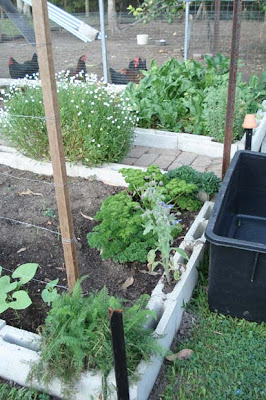These are photos of some of my herbs, taken this morning. This is yarrow, borage, parsley, oregano, with daisies, to attract bees, in the background.
No home garden is complete without herbs. You can use them in your cooking and salads, for medicinal purposes and for crafts; you can make fertiliser and attract bees into the garden with herbs. Some herbs attract insects, some repel them. They're a very interesting group of plants.
A botanist's definition of a herb is a plant that doesn't have a permanent woody stem, like a tree or a shrub. To a gardener, a herb is a useful plant that can be used in cooking or for medicinal purposes. Gardener's use bay trees as herbs, and rosemary, which is a shrub. Even bananas are classed as herbs. It's confused to say the least, but no matter what your definition of herbs, they're great in the garden.
Borage
I grow herbs for cooking, to attract bees, to make fertiliser and to make tea. At the moment I'm growing the following: parsley, borage, lemon balm, mint, garlic, aloe vera, oregano, marjoram, nasturtiums, comfrey, curry plant, Italian thyme, yarrow, lavender and bay.
When growing herbs, they should be grown slowly so their flavours can develop fully. So don't keep pushing them along with fertiliser. Plant them in full sun, in good draining soil and apply a weak liquid fertiliser three weeks after planting, and again at 12 weeks. Flowering plants like lavender should be cut back after they flower, which, at the right time of year, will stimulate another flush of flowers.
COMFREY FERTILISER
Cut the green leaves from your comfrey clump and fill a bucket half full of leaves. Place a brick, or something heavy, on the leaves to keep them under the water. Fill the bucket to the top with water. Place a lid on the bucket - this stinks to high heaven when it's ready to use - and leave in a shaded place for three weeks. When you take the lid off, be prepared for a bad smell, but this brew is FULL of nitrogen.
To use, pour one litre (1 quart) of the mix into a nine litre (2½ gallon) bucket and fill with water. Pour this onto your plants that need a nitrogen boost, like lettuce, spinach and the leafy vegetables. Pour any left overs onto your compost, it speeds up decomposition of decaying plant material.
Comfrey
Comfrey is grown from root cuttings and it loves slightly moist conditions. When you plant comfrey, make sure you choose a space where it can grow forever. Comfrey doesn't run, like bamboo, but it forms a nice big clump and the tiniest piece of root will regenerate. So if you try to remove it and leave any piece of plant behind, it will regrow.
GARLIC SPRAY
Chop up 100 grams (3½ oz) of garlic cloves and mix with 2 tablespoons of cooking oil. Leave to infuse for 48 hours. Dissolve 2½ tablespoons of pure soap (homemade is good for this) in 500mls (16 fl oz)) hot water and mix everything together. Strain the mix to remove the garlic and store in a glass or plastic container. To use, dilute the garlic mix with ten times the amount of water and spray on insects. This is a contact spray so it has to be sprayed onto the insects, but it doesn't harm you or the plant.
LEMON BALM TEA
Pick fresh leaves - you'll need about 30 leaves - wash them. Place the leaves in 2 cups of boiling water in a tea pot and allow to infuse for 5 minutes. Strain the leaves before drinking. A small teaspoon of honey is a delicious addition.
HEALING WITH ALOE VERA
When I cut or burn myself, I squeeze the gel from a piece of aloe vera and rub it on. It always works well. Some people with sensitive skins may develop a rash using aloe vera, so test a small patch of skin before using it.
PARSLEY AND MINT CLEANSER
Pick a large bunch of paisley and about 2 tablespoons of mint leaves. Add to 500mls (16 fl oz)boiling water and allow to infuse for one hour, then strain through a fine filter. When cool, use this as a facial cleanser. It will store for three days.
Parsley and oregano.
LAVENDAR OR ROSE WATERPlace 120 grams (4oz) fresh lavender flowers or rose petals in a china or ceramic (not aluminium) bowl and pour over 500 mls (16 fl oz) boiling water. Place a clean cotton cloth on top and allow to steep overnight. Strain off the flowers and store in a glass bottle. This is nice as a facial splash but I usually use it instead of plain water when spraying my ironing.
Lavender
You can use herbs in so many ways and I could write about them all day and still not tell you all their wonderful uses. So next time you're at a friends house and see a herb you like, ask for a cutting and instructions on growing it. It might also help if you borrow a book on herbs from the library, they make fascinating reading. This is the most valuable website about herbs that I've found. It's the wonderful Isabel Shipard's site, full of information and enthusiasm for herbs and how we can use them.





